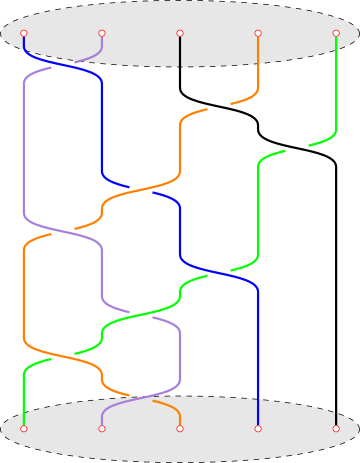2. Fundamental Groupoid
Path connected component
Definition 2.1. Let .
• | A map is called a path from to . |
• | We let denote the path from to defined by . |
• | We let denote the constant map to . |
Let us introduce an equivalence relation on byWe denote the quotient space bywhich is the set of path connected components of .
Theorem 2.2. defines a covariant functor from to .
Corollary 2.3. If are homotopy equivalent, then .
Path category / fundamental groupoid
Definition 2.4. Let be a path. We define the path class of by
is the class of all paths that can be continuously deformed to while fixing the endpoints.
Definition 2.5. Let such that . We define the composite pathby
Proposition 2.6. Let be paths, such that , , . Then
We conclude that is well-defined for path classes
Proposition 2.7 (Associativity). Let such that and . Then
Proposition 2.8 (Identity). Let with endpoints and . Then
Proof. We only show the first equality, which follows from the figure below:
Definition 2.9. Let . We define a category as follows:
• | . |
• | =path classes from to . |
• | . |
The propositions above imply that is a well-defined category. is called the path category or fundamental groupoid of .
Groupoid
Definition 2.10. A small category where all morphisms are isomorphisms is called a groupoid. All groupoids form a category .
Example 2.11. A group can be regarded as a groupoid with
• | consists of a single object. |
• | and composition is given by the group multiplication. |
Thus we have a fully faithful functor .
Recall that is the inverse of .
Theorem 2.12. Let with endpoints and . ThenIn other words, all morphism in are isomorphisms and thus is a groupoid.
Exercise 2.13. Use the following figure to give another homotopy for Theorem 2.12.
Let be a groupoid, and define the setwhere if and only if in . We can view as a (discrete) category whose objects are its elements with only identity morphisms. Then defines a functor from to (the analogue of path connected components). We say is path connected if is a single point.
Proposition 2.14. is path connected if and only if is path connected.
Definition 2.15. Let be a groupoid. We define the automorphism group of an object to beNote that this indeed forms a group.
For any , it induces a group isomorphismIn terms of diagrams,
This naturally defines a functorSpecialize this to topological spaces, we find a functor
Definition 2.16. Let , the groupis called the fundamental group of the pointed space .
Theorem 2.17. Let be path connected. Then for any , we have a group isomorphism
Let be a continuous map. It defines a functor
Proposition 2.18. defines a functorthat sends to .
Proposition 2.19. Let be maps which are homotopic by . Let us define path classesas illustrated in the figure below:Then defines a natural transformation
This proposition can be summarized by the following diagram.The next theorem is a formal consequence of the above proposition
Theorem 2.20. Let be a homotopy equivalence. Thenis an equivalence of categories. In particular, it induces a group isomorphism
Proposition 2.21. Let . Then we have a canonical isomorphism of categoriesIn particular, for any , we have a group isomorphism
Example 2.22. For a point , is trivial. It it not hard to see that is homotopy equivalent to a point. It follows that
Example 2.24. Let be the -dim torus. Then
Example 2.25 (Braid groups). Artin’s braid group of strings can be realized as mapping class group (symmetry group) of a disk of punctures. It has the following finite presentation: Braid groups can be also realized as fundamental groups.
Let . The (ordered) configuration space of is the set of pairwise distinct points in : There is a natural action of the permutation group on given by The unordered configuration space of is the orbit space of this action:
A classical result says
Moreover, elements in this (fundamental) group can be visulized as braids in as follows. Fix distinct points in . A geometric braid is an -tuple of paths such that
• | ; |
• | for some permutation of ; |
• | are distinct points in , for any . |
